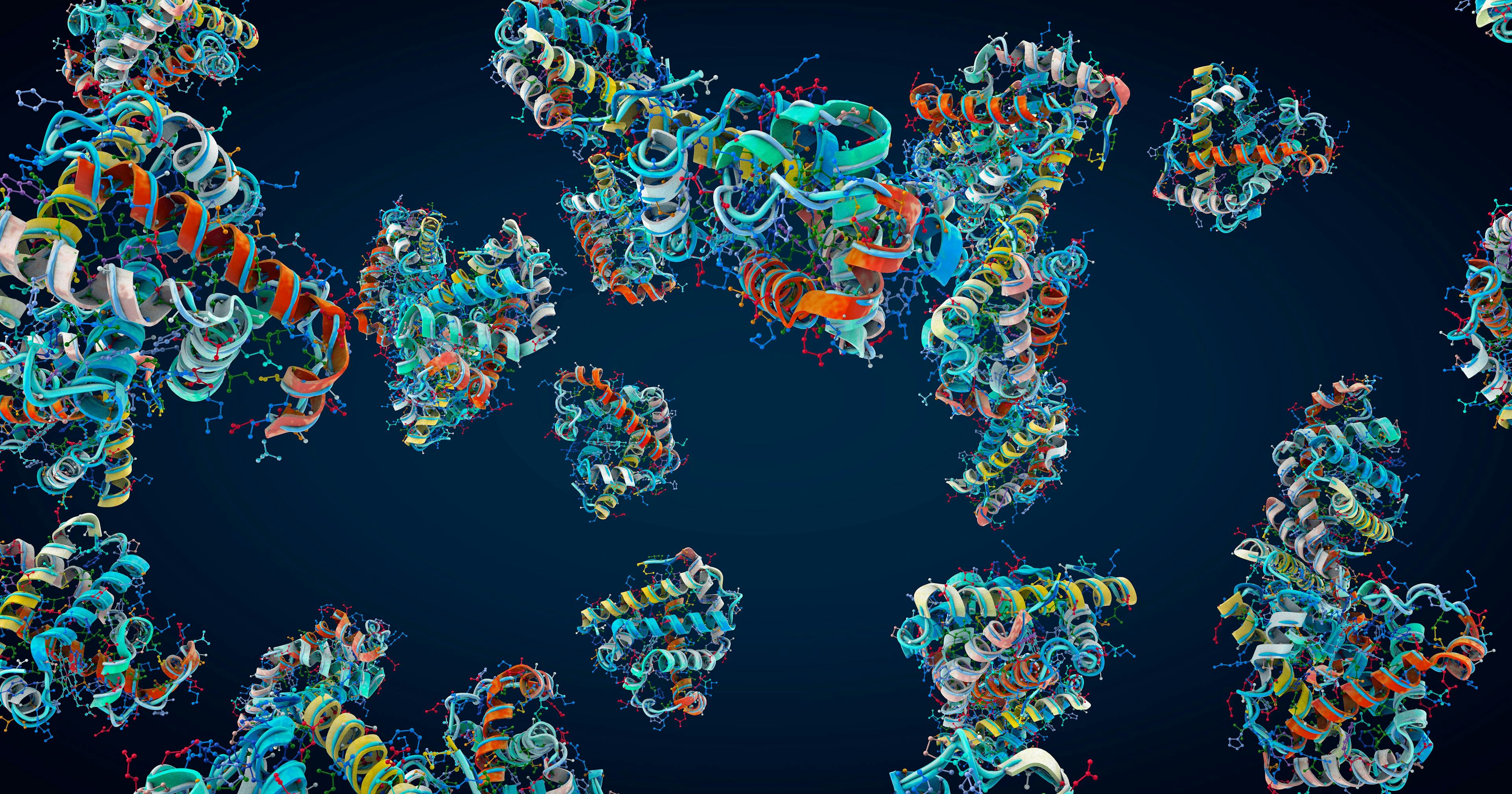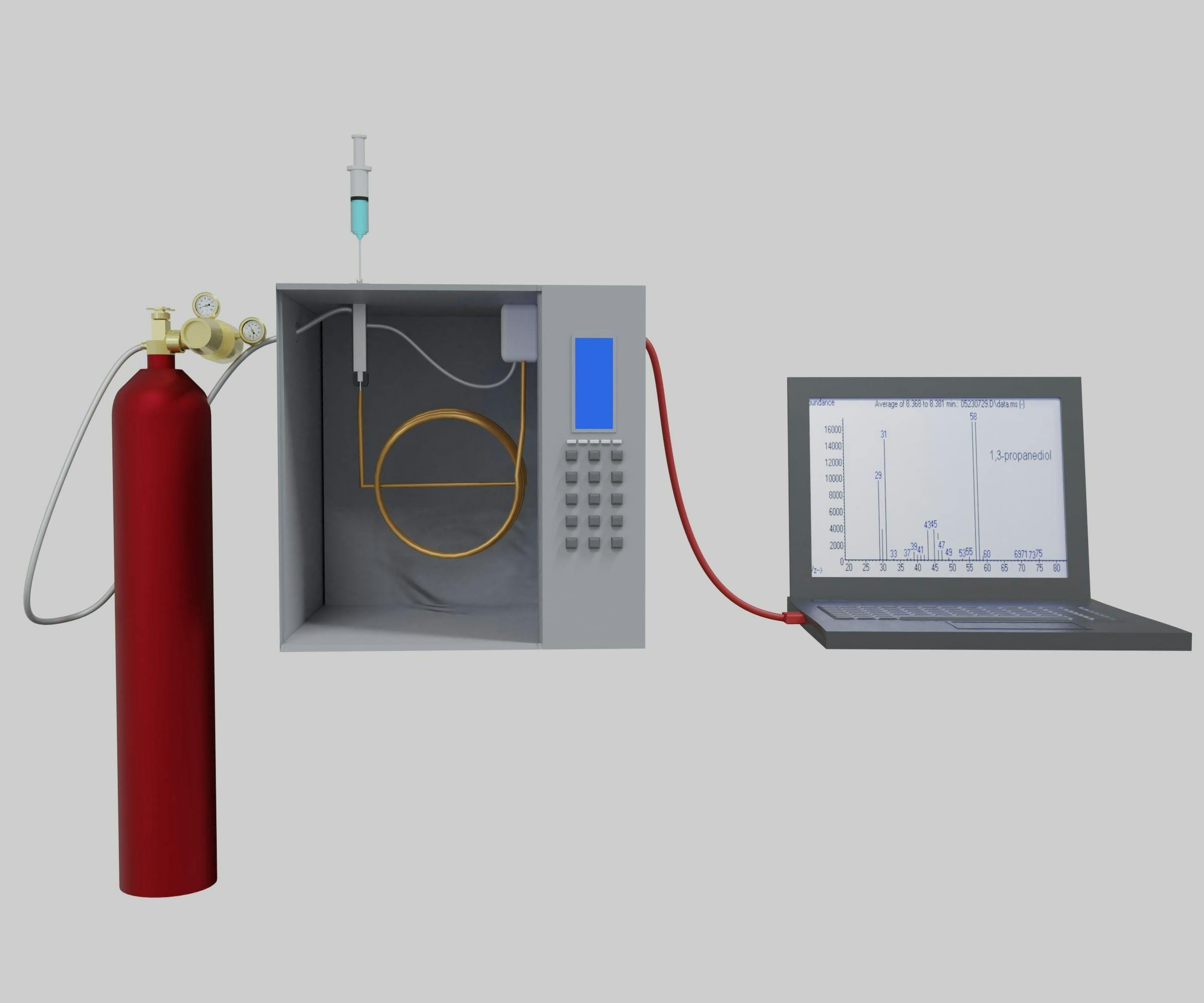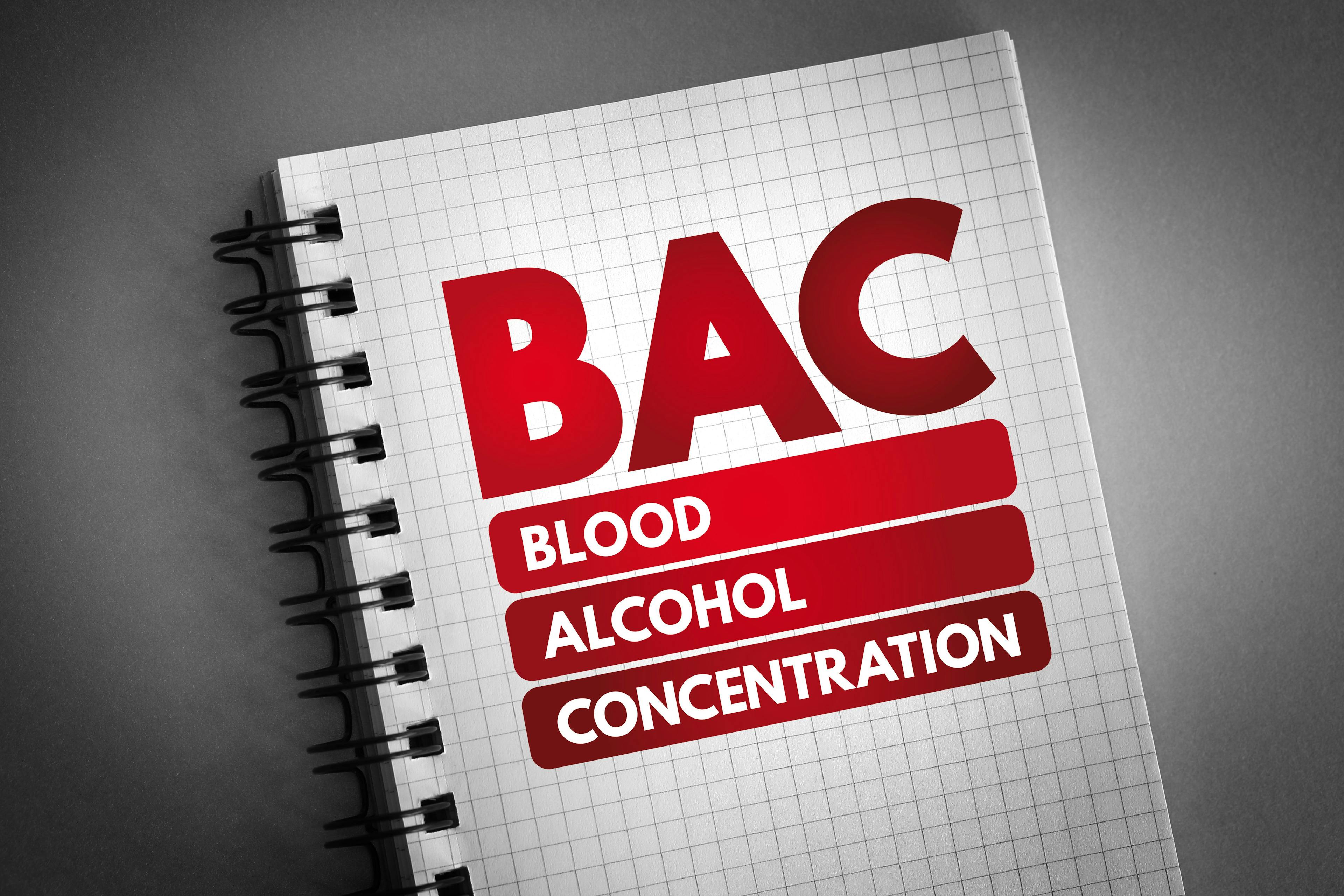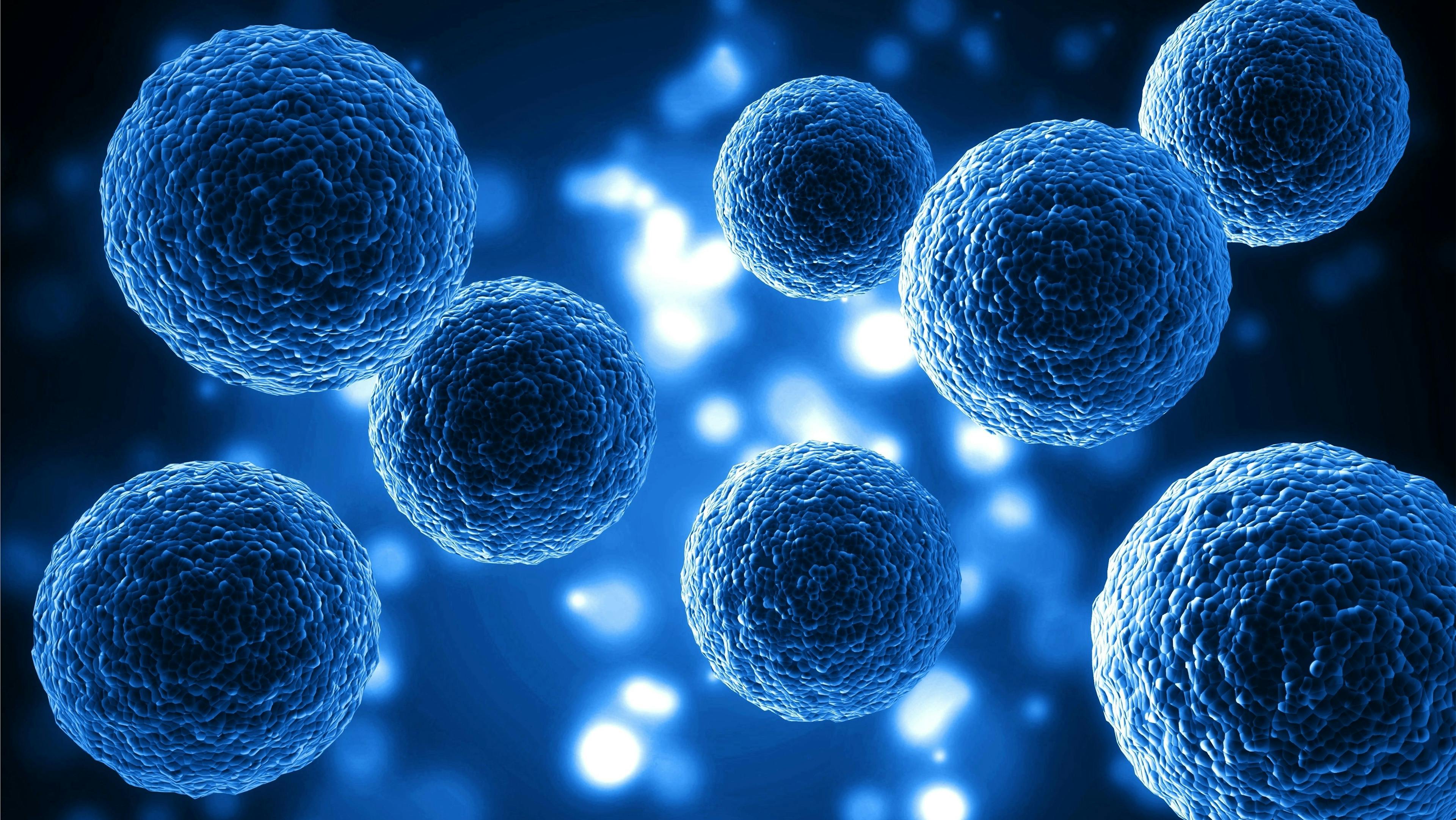Wastewater Surveillance of Pharmaceuticals and Genes: Challenges and Opportunities
Wastewater-based epidemiology (WBE) using viral nucleic acids to predict community viral outbreaks has many challenges, including interferences from the wastewater matrix. Liquid chromatography with tandem mass spectrometry (LC–MS/MS) monitoring of pharmaceutically active compounds, such as antivirals and over-the-counter drugs commonly used to relieve the symptoms of infection, could complement information provided by molecular techniques. For instance, residues of drugs associated with managing Covid-19 symptoms, including azithromycin, chloroquine, hydroxychloroquine, and lopinavir, have been detected in influent wastewater. A significant correlation can be observed between the total of Covid-19–related drugs detected and the 5-day rolling averages of reported cases. Spikes in acetaminophen concentrations can also be observed a couple of weeks before a spike in SARS-CoV-2 RNA copies in wastewater, suggesting that over-the-counter analgesic concentrations in raw sewage may be used to complement viral RNA data as an early-warning system for effective management of viral outbreaks at the community level. Sample preparation and analysis of pharmaceuticals in wastewater present unique challenges and are discussed in this article.
Municipal wastewater presents a wealth of information that provides a snapshot of a community’s collective health, including biomarkers that can be linked to different life styles (such as illicit drug use or pharmaceutical consumption). Since the onset of the Covid-19 pandemic, researchers around the world have taken advantage of the opportunity to harness information from wastewater by measuring RNA fragments of the SARS-COV-2 virus in raw sewage to track community disease outbreak at an early stage. Data from wastewater surveillance of viral RNA fragments using real-time quantitative polymerase chain reaction (RT-qPCR) have demonstrated that wastewater-based epidemiology (WBE) can be used as a reliable early warning of an outbreak. In fact, there is evidence that suggest that the Omicron variant was present in New York City’s wastewater more than a week before the first case of this variant was reported in the United States (1). As a result, the potential of WBE to provide a sensitive signal for tracking the spread of pathogens and complement clinical data to determine whether the pathogen is present in the population and whether transmission is increasing or declining has been recognized worldwide (2–4).
Recently, we showed that in addition to monitoring viral RNA fragments in wastewater, measuring the concentrations of pharmaceutical residues can add another layer of information that reveals the state of community health (5). In our study, we used liquid chromatography with tandem mass spectrometry (LC–MS/MS) to quantify a suite of pharmaceutically active ingredients in raw sewage (untreated municipal wastewater), ranging from over-the-counter pain killers (such as acetaminophen) to antiviral drugs (such as lopinavir). Notably, elevated concentrations of acetaminophen (>200 ug/L) in wastewater were observed, which peaked approximately 2–2.5 weeks earlier than the observed spike in SARS-CoV-2 RNA copies. Trends in population-normalized detections of acetaminophen in wastewater are shown in Figure 1 in comparison to SARS-CoV-2 RT-qPCR data and the estimated clinical cases of Covid-19 in one of the sewersheds monitored. The gap between the acetaminophen peak and the highest number of RNA copies detected may be attributed to the incubation period of the virus in the human body, the inability of genome-determination techniques to quantify trace concentrations of viral genomes, and a lag in significant community spread of Covid-19. Moreover, the incubation period of SARS-CoV-2 ranges from 2–14 d, with 8 d post-onset of symptoms as the expected median duration of viral RNA shedding.
FIGURE 1: Trends in the concentrations of acetaminophen and viral RNA in wastewater compared to Covid-19 cases in the community where the samples were collected. The solid line represents the locally weighted scatterplot smoothing (LOWESS) and the circles represent the actual data points. The cases are represented as (a) population-normalized concentrations of detected acetaminophen; (b) wastewater severe acute respiratory syndrome coronavirus 2 (SARS-CoV-2) RNA concentrations; and (c) estimated clinical cases of coronavirus 2019 (Covid-19) of Bird Island wastewater treatment plant. Figure is adapted from reference (5).
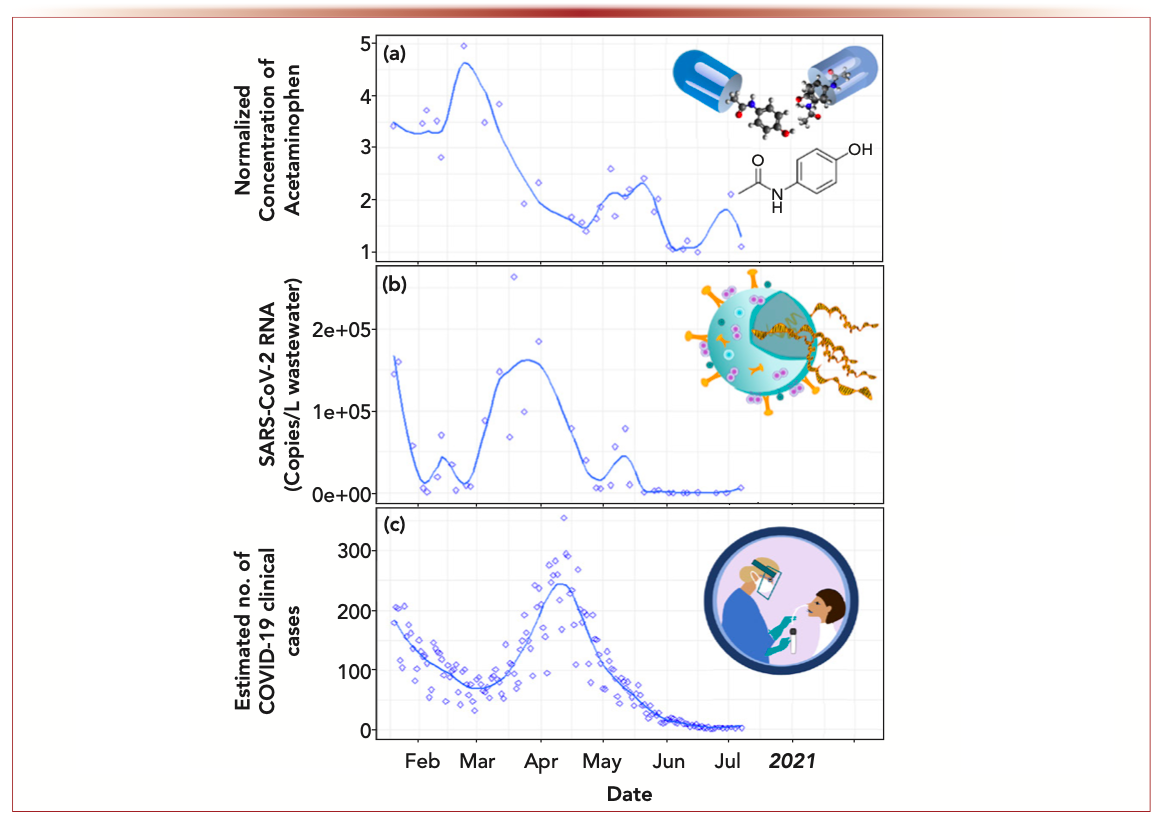
The community clinical data show that the number of reported cases spiked in early April, which corresponds to approximately a week after the observed maximum in SARS-CoV-2 RNA copies in wastewater. This gap is not surprising given that Covid-19 testing is typically performed a few days after infection occurs. Because acetaminophen is a widely used analgesic and is excreted at an average of 4% as the unchanged parent compound that remains stable in wastewater for up to 12 h, acetaminophen residues could be another suitable surrogate to predict community health using WBE. One advantage offered by LC–MS/MS analysis of pharmaceuticals in WBE is that information about pharmaceutical concentrations can be related to a broader spectrum of infections that may cause potential community outbreak, rather than being specific only to Covid-19 outbreak. The concentrations of drugs detected in sewage can complement RNA data obtained by RT-qPCR techniques, especially when the concentrations of RNA are below the limit of detection (LOD), or if variants of the viruses occur. Data from LC–MS/MS analysis of pharmaceutical residues in wastewater can be particularly useful when new variants of viruses appear and escape detection by molecular techniques. Recently, the most transmissible Omicron variant yet, BA.5, is causing fresh waves of cases that remain unreported because many people are now testing at home. Therefore, monitoring of pharmaceutical residues in wastewater could become a very important tool for tracking the spread of Covid 19 that can help health professionals prepare for outbreaks, or prevent recurrence of a pandemic.
Conventional WBE studies use qPCR to determine the levels of viral RNA load in wastewater, but this technique is prone to matrix interferences, resulting in high LODs (6). In the past few years, many studies have demonstrated the potential of using information on the concentrations of the active ingredients of pharmaceuticals in wastewater to signal prevalence of multiple other diseases in the community (7–9). The use of LC–MS/MS in the latter approach offers the advantage of gaining information on multiple pharmaceutical residues simultaneously at very low levels, which may be correlated with different infectious disease outbreaks. In our recently published study, a set of 64 pharmaceuticals was targeted for quantification using LC–MS/MS with electrospray ionization (ESI). To minimize matrix interferences and achieve low LODs, samples were concentrated and cleaned up using solid-phase extraction (SPE) based on the hydrophilic-lipophilic balance (HLB) sorbent. Despite the broad selectivity of the HLB SPE sorbent, not all of the target analytes were recovered with high extraction efficiency. Many of the antiviral drugs had poor extraction recoveries because of their highly polar nature. To evaluate matrix effects on the extraction efficiencies using HLB SPE, recovery studies were performed in fortified distilled water and in influent wastewater. Figure 2 shows the results of the average extraction recoveries in the two matrices. A threshold of 60% recovery was arbitrarily assigned to be the cut-off for “acceptable” recoveries. In a distilled-water matrix, 27 out of 64 target analytes showed ≥60% average recoveries, while only 10 analytes showed ≥60% average recoveries in influent wastewater matrix. These results indicate that the HLB sorbent alone, which is the most commonly used SPE sorbent in the analysis of pharmaceuticals in wastewater, is not capable of capturing many of the antiviral drug residues because of their highly polar nature. Therefore, there is a need to investigate other types of SPE sorbents, or examine the use of more than one type of sorbent, employed in tandem, when extracting pharmaceuticals in raw sewage.
FIGURE 2: Average extraction recoveries (n = 3) of (a) antivirals, (b) analgesics/antileptics and, (c) other targeted pharmaceuticals and personal care products in pure water and influent wastewater (spike concentration: 200 μg/L). Abscissa label is the Name of pharmaceutical product measured.
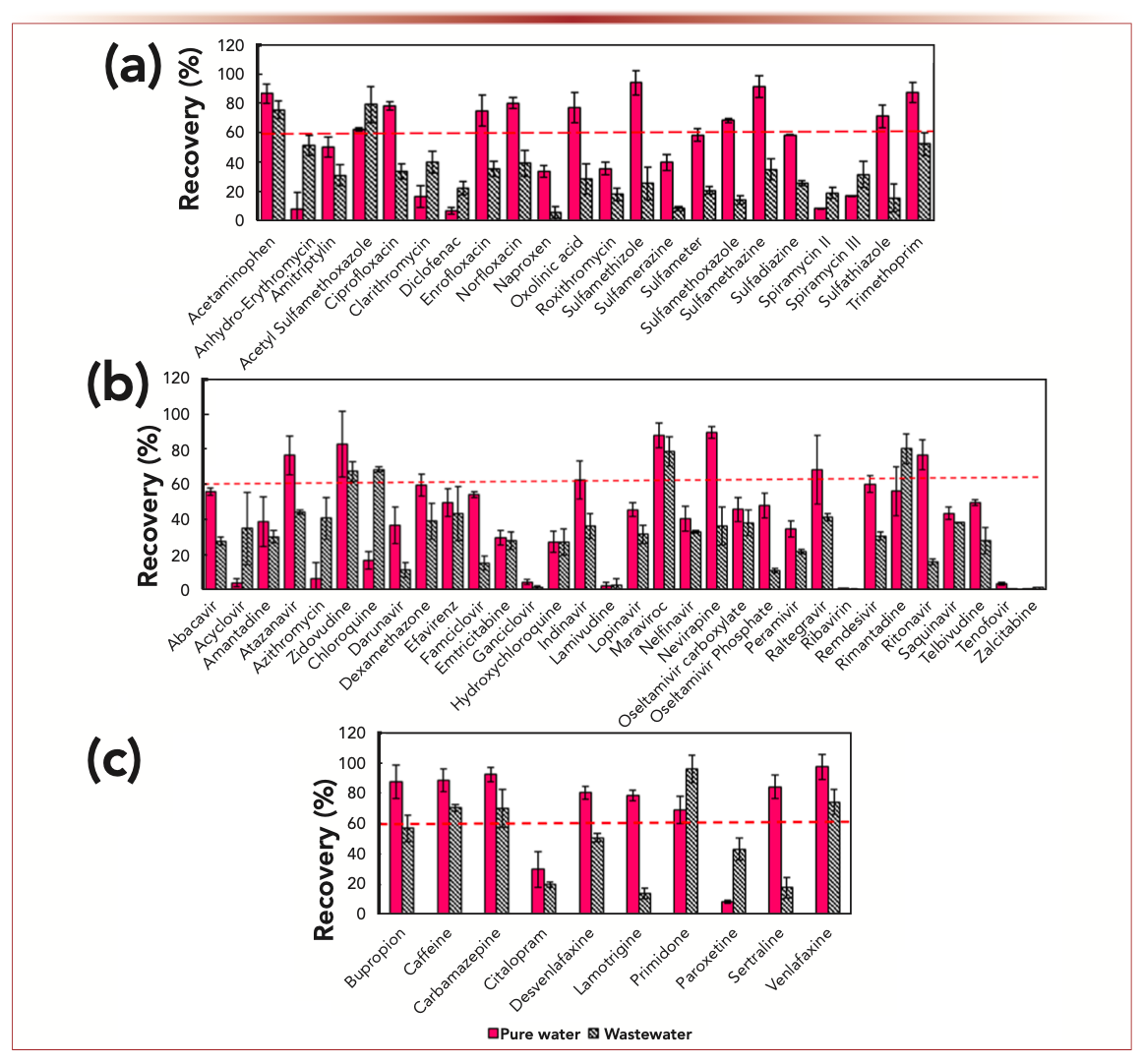
Our study based on targeted LC–MS/MS analysis quantified a limited set of analytes in wastewater, despite the presence of multiple other analytes in wastewater that could potentially serve as biomarkers for other disease occurrence in the community. Transformation products and metabolites of pharmaceuticals were not included in the study, but they are important to monitor to broaden the applications of WBE in predicting disease outbreaks. To determine which metabolites are stable and abundant in wastewater, a non-targeted LC–MS/MS analysis is needed to provide unbiased data wherein “all” the features detected in the samples are characterized and identified. Non-targeted analysis using high-resolution mass spectrometry (HRMS), with mass analyzers such as time-of-flight (TOF) and orbital ion trap MS systems, will allow expansion of the detection coverage to identify additional chemicals in WBE studies. HRMS acquires data with high mass accuracy in MS and multistage mass spectrometry (MSn) experiments, providing the opportunity to store spectra and later screen for the presence of additional compounds of interest. Retrospective analysis of data from HRMS can reveal new compounds that are not typically included in targeted analysis using low resolution LC–MS/MS (10). To facilitate identification of a larger set of compounds, high-efficiency analytical columns capable of separating a wide range of compounds are essential, in order to retain highly polar analytes and separate isobaric compounds. Advanced column technologies for ultrahigh-pressure LC (UHPLC) instruments should be explored for simultaneous analysis of a wide range of polar and nonpolar analytes in non-targeted HRMS.
In summary, there is high potential for using information obtained from chemical analysis to complement the data from genetic analysis during wastewater surveillance to better predict occurrences of disease outbreaks. Key to the success of this early warning approach is the ability of the analytical method to achieve highly efficient separation of a wide range of analytes, and detect them with high signal-to-noise (S/N) ratios in the complex matrix of untreated wastewater. Although drug concentrations in raw sewage alone will not be able to single out the specific disease that leads to the increased consumption of pharmaceuticals, there are many opportunities for these data to provide a much earlier warning than clinical data, especially when diseases are not recorded, or where viral RNA detection in wastewater is not possible because of their trace concentrations. A surveillance system that provides an early warning for a range of potential community disease outbreaks could be beneficial for the healthcare system and providers in preparing for future catastrophic events.
References
(1) A.E. Kirby, et al, MMWR Morb Mortal Wkly Rep. 71(3), 103–105 (2022). DOI: 10.15585/mmwr.mm7103a5.
(2) D. Barceló, Case Stud. Chem. Environ. Eng. 2, 100042 (2020).
(3) D. Panchal, O. Prakash, P. Bobde, and S. Pal, Environ. Sci. Pollut. Res. Int. 28(18), 22221–22240 (2021).
(4) K. Mao, K. Zhang, W. Du, W. Ali, X. Feng, and H. Zhang, Curr. Opin. Environ. Sci. Health 17, 1–7 (2020).
(5) L.M. Halwatura, I.S. Mclerran, D.L. Weglarski, Z.U. Ahmed, Y. Ye, I.M. Bradley, and D.S. Aga, Environ. Sci. Technol. Lett. 9(6), 567–574 (2022).
(6) T. Kumblathan, Y. Liu, G.K. Uppal, S.E. Hrudey, and X.F. Li, ACS Environ. Au 1(1), 18–31 (2021).
(7) F. Ahmed, B. Tscharke, J. O’Brien, J. Thompson, S. Samanipour, P. Choi, J. Li, J.F. Mueller, and K. Thomas, Sci. Total Environ. 715, 136925 (2020).
(8) D. Vitale, M.M. Suárez-Varela, and Y. Picó, Current Opinion in Environmental Science & Health 20, 100229. (2021).
(9) J.H. Yan, Y. Xiao, D.Q. Tan, X.T. Shao, Z. Wang, and D.G. Wang, Chemosphere 222, 688–695 (2019).
(10) L.F. Angeles, S. Islam, J. Aldstadt, K.N. Saqeeb, M. Alam, M.A. Khan, F.T. Johura, S.I. Ahmed, and D.S. Aga, Sci. Total Environ. 712, 136285 (2020).
Diana S. Aga is Director of RENEW Institute and the Henry M. Woodburn Professor of Chemistry at the University at Buffalo (UB), part of The State University of New York, Buffalo, NY. Direct correspondence to: dianaaga@buffalo.edu

Lahiruni M. Halwatura is a PhD student at the Aga Laboratory for Environmental Research & Testing (ALERT) at UB. Direct correspondence to: dianaaga@buffalo.edu


University of Rouen-Normandy Scientists Explore Eco-Friendly Sampling Approach for GC-HRMS
April 17th 2025Root exudates—substances secreted by living plant roots—are challenging to sample, as they are typically extracted using artificial devices and can vary widely in both quantity and composition across plant species.
Common Challenges in Nitrosamine Analysis: An LCGC International Peer Exchange
April 15th 2025A recent roundtable discussion featuring Aloka Srinivasan of Raaha, Mayank Bhanti of the United States Pharmacopeia (USP), and Amber Burch of Purisys discussed the challenges surrounding nitrosamine analysis in pharmaceuticals.









